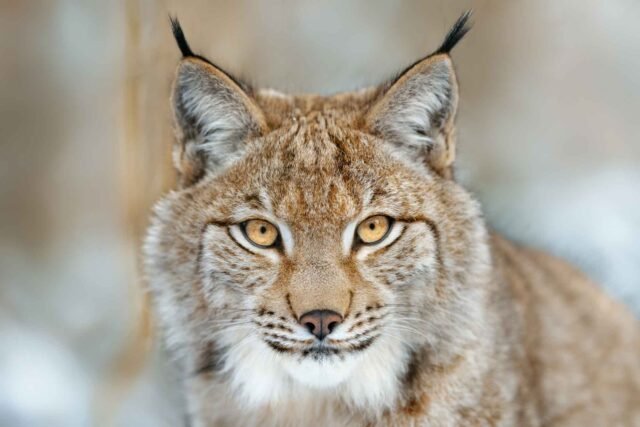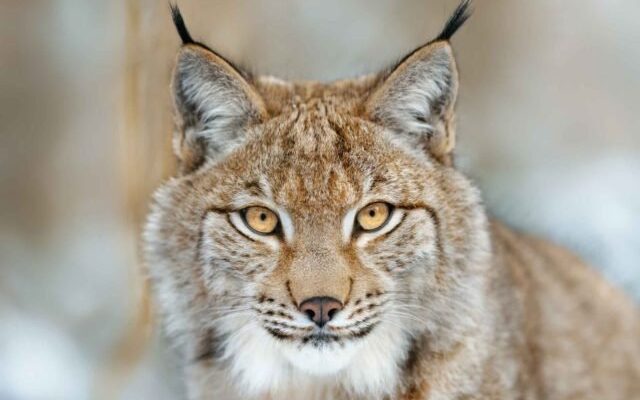
The Eurasian Lynx is not just a pretty face; it’s a remarkable creature with unique traits and behaviors. From its fluffy tufts of fur on its ears to its ability to thrive in various habitats, there’s so much more than meets the eye. So, let’s dive into ten fascinating facts about this magnificent mammal together and unravel the mysteries that surround it!
1. A Distinctive Appearance
The Eurasian Lynx boasts a striking appearance that sets it apart from other wild cats. Its most notable features include long, tufted ears and a short tail, which gives it a unique silhouette among its feline cousins. If you’ve ever seen a lynx, you might have noticed how its coat changes with the seasons. In winter, it sports a thick, soft fur that helps it stay warm in icy temperatures, while in summer, it sheds some of that fluff for a sleeker look.
Another interesting detail is its stunning facial markings. The lynx has a white spot under its chin and a distinctive beard of fur, which gives it an endearing, almost whimsical expression. You might be wondering why those ear tufts exist. Scientists believe they enhance the lynx’s hearing, helping it to detect even the faintest sounds of prey moving through the underbrush.
2. Masters of Camouflage
One of the lynx’s greatest survival skills is its incredible ability to blend in with its surroundings. The Eurasian Lynx has a coat that consists of a mix of browns and grays, allowing it to disappear among the trees and foliage of its forest habitat. This camouflage is essential for stalking prey, as it can approach animals without being detected.
Imagine a cat quietly prowling through the woods. The Eurasian Lynx does just that, relying on its keen eyesight to spot movement and its acute hearing to locate sounds. When the moment is right, it pounces with remarkable speed and agility. This strategy is not just about hunting; it’s about survival in a world full of predators and competition.
3. Their Diet is Diverse
Eurasian Lynxes are carnivorous and have a varied diet that includes a range of prey. These cats primarily hunt medium-sized animals, like deer, hares, and birds. One interesting fact is that lynxes can consume animals up to three times their own weight! But they aren’t picky eaters. They adapt their hunting habits based on the availability of prey in their territory.
During harsh winters, when food is scarce, these crafty hunters will even go after smaller mammals like rodents. Their ability to change their diet helps them thrive in different ecosystems. This flexibility shows just how resourceful the Eurasian Lynx truly is.
4. Habitat and Range
The Eurasian Lynx has one of the most extensive ranges of any wild cat. You can find them across various habitats in Europe and Asia, from the snowy forests of Scandinavia to the more temperate woodlands of Central Europe and all the way to the rugged mountains of Siberia. This adaptability makes the lynx quite the survivor.
While they prefer dense forests, they can also thrive in mountainous terrains and even semi-arid regions. The lynx’s ability to adapt to different environments has helped maintain its population, despite habitat loss in some areas. However, conservation efforts are essential to protect their habitats and ensure they can continue to roam free.
5. Solitary Lifestyle
Unlike lions, which are known for their pride-driven social structures, the Eurasian Lynx is predominantly solitary. These cats value their alone time and prefer to hunt and roam independently. You might find a male and female pairing up only during mating season, after which they go their separate ways.
This solitary behavior offers a couple of advantages. It allows them to establish their own territories without competition from others. Males have larger territories than females, which they roam to mark their presence with scent markings. It’s like putting up a “No Trespassing” sign, ensuring they have enough space and resources for themselves.
6. Vocalizations and Communication
Even though they’re solitary, Eurasian Lynxes still communicate with each other, mainly through sounds and scent markings. They have a range of vocalizations, from growls and hisses to yowls and purrs. These sounds are particularly common during mating season when males and females are trying to attract each other.
You might be surprised to learn that they also use visual signals. A lynx will often scratch trees and leave scent markings to communicate their presence to other lynxes in the area. It’s a discreet way of saying, “Hey, I’m here!” These communications are crucial for maintaining their territory and finding mates.
7. Breeding and Raising Young
Breeding season for the Eurasian Lynx typically occurs between late winter and early spring. After a gestation period of about 70 to 80 days, a female lynx gives birth to a litter of one to four kittens. These little furballs are born blind and rely on their mother for food and protection during their early weeks.
Watching a mother lynx care for her young is a heartwarming sight. She’ll keep her kittens hidden in a den, often made in dense vegetation or rocky crevices, until they’re old enough to venture out. The kittens start exploring their surroundings at around two months and learn essential hunting skills by observing their mother. It’s a period of growth and discovery that prepares them for their solitary lives as adults.
8. Conservation Status and Threats
The Eurasian Lynx is currently classified as a species of Least Concern by the IUCN, but this doesn’t mean they’re out of danger. Habitat loss, poaching, and conflicts with humans remain significant threats to their populations. In some areas, their habitat is fragmented due to urban development and logging, making it challenging for them to find mates and prey.
Conservation efforts are underway in many regions to protect their habitat and mitigate human-wildlife conflicts. By raising awareness and promoting coexistence, groups work to ensure that this magnificent feline continues to thrive in the wild. It’s a reminder that even though the Eurasian Lynx is resilient, it needs support to navigate the modern world.
9. Cultural Significance
The Eurasian Lynx has a rich history in folklore and culture across various regions where it lives. Many cultures view the lynx as a symbol of mystery and independence. Stories often depict it as a wise and cunning creature, revered for its hunting prowess and elusive nature.
In some areas, people believe the lynx possesses supernatural powers, able to see into the unseen. This cultural significance highlights the bond between humans and nature, showing how these majestic animals inspire awe and respect. It’s fascinating how a creature like the lynx can not only survive but also capture the imagination of so many.
10. The Importance of the Eurasian Lynx
Eurasian Lynxes play a vital role in maintaining the ecological balance of their habitats. As apex predators, they help control the populations of herbivores like deer, which, if left unchecked, can lead to overgrazing and damage to vegetation. By keeping these populations in check, lynxes contribute to a healthier ecosystem.
Furthermore, their presence can be a sign of a healthy environment. When lynxes thrive, it often indicates that their ecosystem is functioning well. Protecting them means ensuring the sustainability of their habitats for countless other species. So, every time we work towards conserving the Eurasian Lynx, we’re not just saving one species; we’re helping many others thrive alongside it.
In conclusion, the Eurasian Lynx is an incredible feline with unique traits that make it a fascinating subject of study. From their striking appearance to their critical role in the ecosystem, there’s much to admire about these elusive cats. By understanding and appreciating their place in the wild, we can contribute to their conservation, ensuring they continue to inspire future generations. So, the next time you hear about the Eurasian Lynx, remember the stories of resilience and wonder they embody in the wild.

